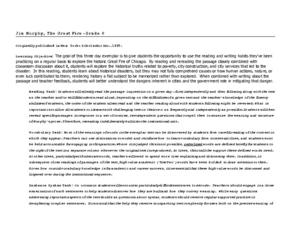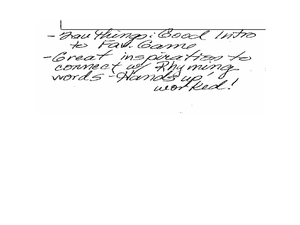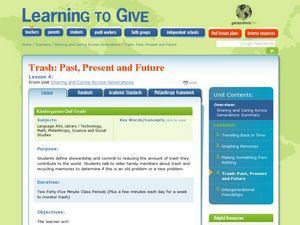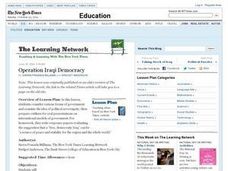Curated OER
Play with Powerful Poetry
Use stations to teach skills relevant to the Common Core and tap into individual creativity.
Curated OER
Anticipation Guide for The Crucible
Before reading The Crucible with your ninth graders, give your class this prereading guide. They write agree or disagree for nine statements listed. Example statement: Honesty is always the best policy. What makes this guide even better...
Scholastic
Teaching with Aesop's Fables
Bring the applicable morals of Aesop's Fables to your classroom with a series of reading comprehension activities. With 12 different fables with activities and exercises, the packet focuses on the ways learners can apply the fables and...
Science 4 Inquiry
Expanding the Universe
When Einstein first heard the theory of the expanding universe, he dismissed it as bad physics. Now scholars learn about the theory and how scientists prove it has merit. Through a hands-on simulation and videos, class members measure...
Curated OER
Jim Murphy, The Great Fire - Grade 6
The Great Fire by Jim Murphy provides the text for a study of the Chicago fire of 1871. The plan is designed as a close reading activity so that all learners have the same background information require for writing. Richly detailed, the...
Heritage Foundation
The Office of the Executive
An executive is not just a leader of a company; you can also use the term to describe the president of the United States. The ninth part of a 20-part unit teaches high schoolers about the importance of the executive branch and the...
Close Up Foundation
Rights Auction
In an engaging activity on universal and unalienable rights, learners work in groups to establish a democratic nation and determine what principles they want to protect to ensure a democratic society. They conduct a "rights auction" in...
Virginia Department of Education
Cell Parts
What do a bird, an egg, a rabbit, and a toad all have in common? This fun-filled resource explains the similarities and differences between cells and how all cells are similar, yet all are different. Learners begin by depicting a...
Curated OER
Peter Rabbit Meets Charles Darwin
Students start to think of evolution in terms of populations. The class follows a cartoon scenario of a rabbit population in which there is selection and change of gene frequency. They receive copies of the scenario or the whole thing...
Curated OER
Money
Third graders review the values of quarters, dimes, nickels, and pennies. They discuss how the different types of coins can equal the same amount. Students give examples of ways to make a given amount under $1.00. They explain what the...
Curated OER
Classroom Builder
Students explore music theory by discussing a classic song. In this musical notation instructional activity, students listen to the song "My Favorite Things" and discuss and share their personal tastes with the class. Students practice...
Curated OER
Time, Talent, and Treasure
Students look at how time, talent, and treasure are parts of stewardship and philanthropy. In this stewardship and philanthropy lesson, students complete a Time/Talent/Treasure Survey before discussing the answers in a whole group...
Curated OER
Archaeology and Storytelling
Young scholars identify and interpret both individual families and whole cultures learn about their pasts by collecting and analyzing stories and artifacts. Then they identify that not all archaeological finds readily reveal their...
Curated OER
History of the Periodic Table
Learners sort a group of manipulatives and then explain their organizational system to the class. They discuss the work of scientists trying to organize the elements into a system that made sense and the development of the periodic table.
Curated OER
The Population Explosion: Causes and Consequences
Students use this lesson to focus on population growth and the threat of overpopulation. In groups, they analyze the world birth and death rates to determine the growth rate of the population. As a class, they discuss the causes and...
Curated OER
Mapping Plate Boundaries
Students discover plate boundaries based on the uneven geographic occurrence of geologic hazards. After discussing geologic hazards, students plot different sets of earthquakes and volcanic eruptions on maps.
Curated OER
Favorite Days
Students collect and organize data about themselves. In this data analysis lesson, students discuss their favorite calendar dates and explore ways to display the data.
Curated OER
Our Favourite Halloween Treat
Students conduct a survey about Halloween candy and create a bar graph illustrating the data. For this data analysis lesson, stud nets are introduced to the topic with a discussion and survey, then the class creates a large graph and...
Curated OER
Trash: Past, Present and Future
Students explore how much trash they create. In this recycling instructional activity, students define stewardship and conduct an experiment to see how much trash the class produces in a week. At the end of the week the students...
Alabama Learning Exchange
Experiencing Newton's Laws of Motion
Fifth graders study Newton's three laws of motion in a whole group setting using their textbook as a resource. They work in small groups to create a multimedia presentation of one of the laws to present to the class. They design an...
Curated OER
Progressive Movement in Nebraska and the United States
Students interact with the whole progressive movement and its impact on the U.S. They list the goals of the movement. In addition, they organize primary resources and interpret political cartoons. Each student shares one of their...
Curated OER
Operation Iraqi Democracy
In this lesson, students consider various forms of government and examine the idea of political sovereignty, then prepare outlines for oral presentations on international models of government. For homework, they write response papers...
Curated OER
Victorian America: Reflections of Life in Death
Students, after viewing a video and researching the changes in society during the Victorian period, assess a prediction-confirmation guide to consider how changes in burial customs in the late 1800's reflect the changes in society as a...
Nemours KidsHealth
Germs: Grades K-2
Students demonstrate knowledge about germs. For this health lesson, students investigate what germs are, how to protect the skin by comparing the skin to apple skins, and the proper hand washing technique for getting rid of germs....

























